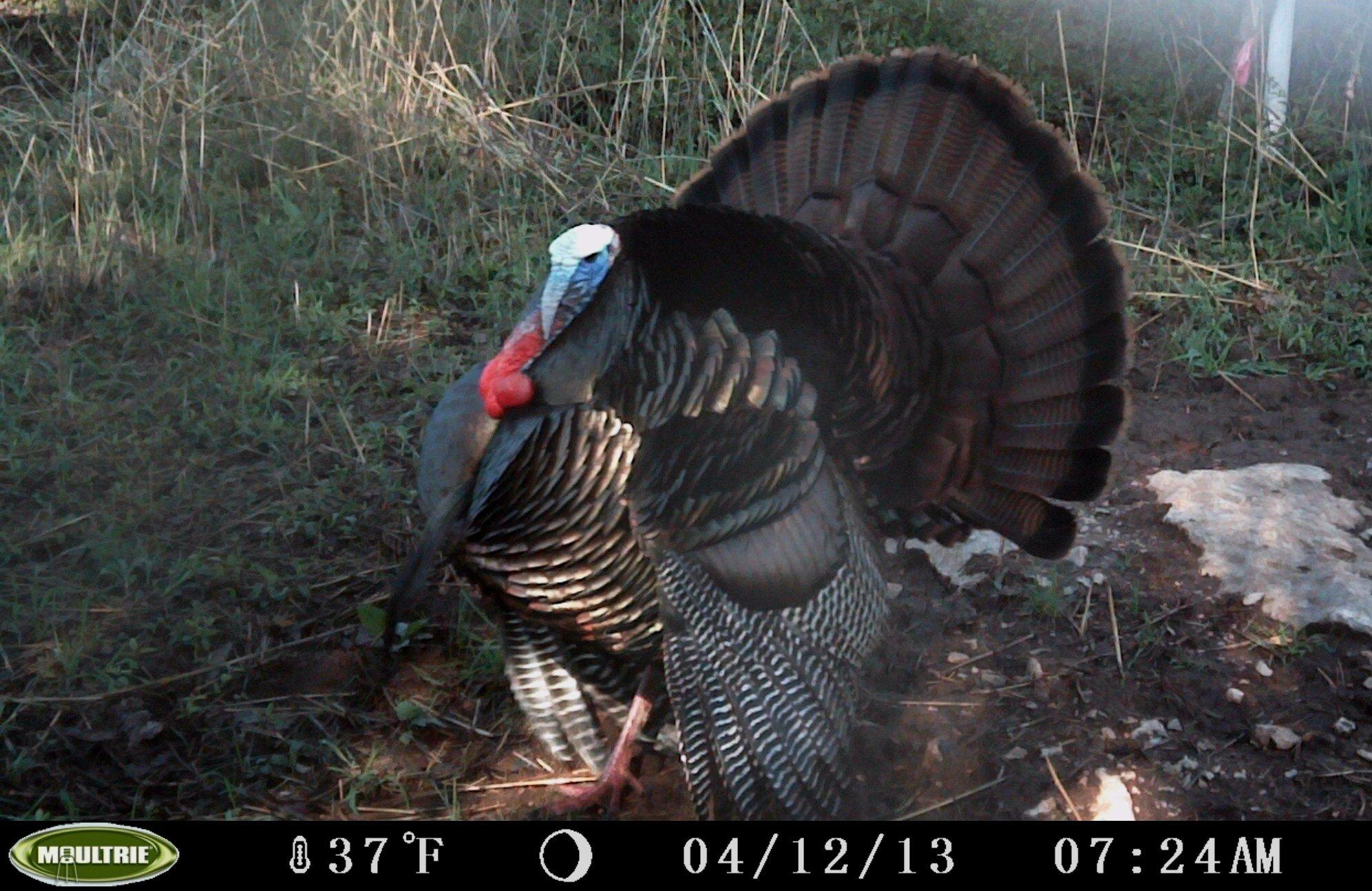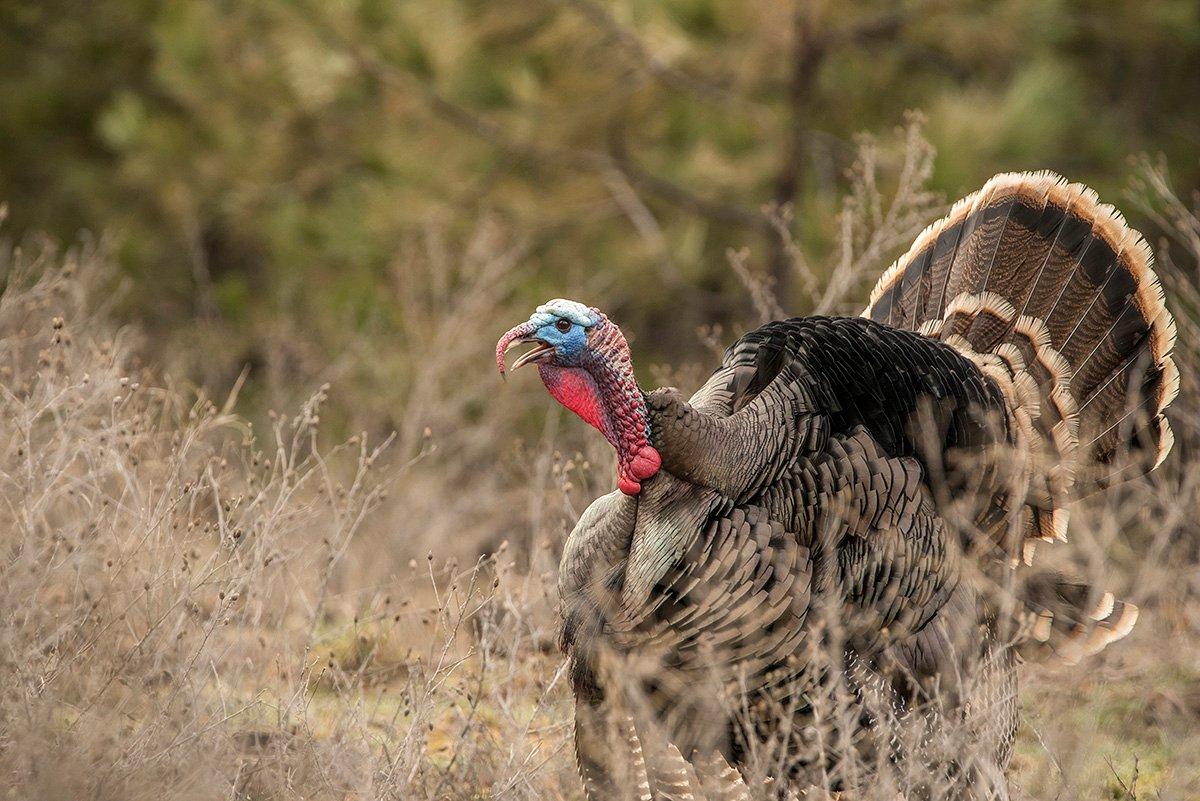These handy tools aren't just for deer
A ground-shaking gobble resonates across the clearing. A few more steps brings him close enough you can smell what he had for breakfast. A sharp cluck and smooth trigger pull put an end to his bantering.
This is what happens when you do your homework. And today's turkey hunter has one of the best study aids ever invented: the trail camera. Here's how to put them to good use this spring.
SCOUTING
There isn't much difference between scouting for deer and scouting for turkeys. The same principles apply. Look for the bedroom and the dinner table. That process begins with aerial maps. Scan them for potential roost sites, feeding destinations, strut zones and travel routes. Mark these areas as potential camera locations.
The next step requires a few early mornings and late evenings. Be on a high point at dawn and dusk so you can hear in all directions. Listen for birds prior to fly-down and fly-up. Listening for gobblers to raise Cain at these two times will reveal major roost sites. Take note of where you hear them.
Now it's time to burn some calories. Slip on the hiking boots and scour the locations marked on the aerial maps for sign. Cameras won't do any good if you don't hang them in high-odds areas.
Try to cover as much ground as possible when hanging pre-season and early-season cameras, said Randy Birdsong, co-host of HeadHunters TV on the Outdoor Channel. Late-winter and early-spring gobblers are still bunched up. Sometimes they can be hard to locate, but if you're able to, you'll be in a better starting spot come spring.
ROOST SITES

You'll know a roost site when you see one. It's not uncommon to see turkey droppings several inches thick under frequently-used trees.
In the East, turkeys have endless options.To narrow the choices, look for mature timber with horizontal limbs. Turkeys also tend to roost in the tallest trees with the most visibility. Heavy concentrations of droppings may be present, but will not be as abundant as in the Midwest.
This is a great place to hang a camera. Find the best trees with droppings underneath them. Back off about 40 feet and hang the camera.
Sign to look for:
- J-shaped droppings under limbs (toms and jakes)
- Spiral-shaped droppings under limbs (hens)
- Primary wing feathers
- Tracks pointing in multiple directions
THE TRAVEL ROUTE
Turkeys aren't like deer. They wander, meander, yet still follow certain travel routes. But turkeys are like deer in some ways. They use the terrain to their advantage. Look for geographical features such as: creeks, bluffs, ridges, thickets, fence gaps, benches, linear openings and anything else that will alter movement.
It's not uncommon to find dust bowls along travel routes. Dust bowls are exposed depressions where toms and hens cover themselves with dirt. This helps reduce parasites.
Sign to look for:
- Tracks pointing in one or two directions
- Dust bowls
- Black-tipped breast feathers (toms)
- Gold-tipped breast feathers (hens)
THE FEED
It's all about the food. While gobblers may not be feeding heavily, hens are doing so in a vigorous manner. And gobblers won't be far behind.
Turkeys feed on a variety of food sources in spring. Mast is one of them. White oak acorns are likely obsolete by now. Red and post oaks may still have acorns under them. Grasses and seeds are also on the menu. Turkeys seem to prefer shorter vegetation over taller grasses. Pastures are great places to find these. That's not to mention the buffet of insects turkeys find under cow piles. If there is one rule to remember, it's that turkeys follow cattle. Hunt near cattle and you won't have a problem finding long-bearded gobblers.
Other great options are food plots. Clover and other choices such as chufa offer prime nutrition. Turkeys are all about the best and easiest meal. Food plots provide that, making them great locations to post trail cameras.
Cameras are great on field edges, said Phillip Vanderpool, host of Dominator 365. In mountainous regions, count on north slopes near water. They drain out and green up faster. When possible, face your cameras north to avoid bright sunlight and overexposed photos.
Spring is a time when farmers are breaking ground for crops. Exposed ground is another hotspot feeding destination. Disced or plowed ground gives turkeys easy access to insects and other creepy crawlers.
Sign to look for:
- Tracks in all directions
- Tom tracks (2½-inch middle toe larger than outside toes)
- Hen tracks (less than 2½-inch middle toe same length as outside toes)
- Use scratching to determine direction of travel while feeding
CAMERA CHOICES
Here are three different cameras that do very different things. Each of them will take your trail camera efforts and boost them to the next level.
Bushnell Trophy Cam HD Wireless:
This isn't just for deer hunters who hate leaving scent near their camera. It's great for turkey fanatics too. That turkey isn't going to smell you. But pressure is pressure whether you're hunting deer, turkeys or gophers.
Moultrie Panoramic 150i:
Who doesn't love a panoramic photo? This camera allows you to capture images in several different directions all in the same photo. No other camera feature does this other than a panoramic-style camera.
Plotwatcher Pro Time Lapse Camera:
This camera gives you the ability to monitor an entire field around the clock. It doesn't even need an animal close by to trigger it. It snaps photos at regular intervals on its own.
STRUT ZONES
This is where gobblers go to post up for the ladies. These are generally mid-morning to mid-afternoon locations where gobblers go once they've lost their hens. This is a great spot for trail cameras because it gives you options for Plan B. You can always retreat to a likely strut zone if you don't get it done off the roost.
Just about any geographical feature can serve as a strut zone. But certain features attract gobblers more than others. Open flats on hilltops, benches along ridges, stretches of roadbed, creek banks and other similar features seem to be typical hotspots. The key is visibility. Gobblers pick strut zones where they can see and be seen. Don't expect to sneak up on a gobbler in his strut zone. I've noticed in my hunting career that strut zones can change. That said, gobblers find areas they prefer and repetitively go back to them.
Sign to look for:
- Wing drag marks (from strutting)
- Tracks in all directions
- More tom droppings than hen droppings
CAMERA SETUP
The overall concept of hanging cameras is the same with turkeys as whitetails. But take into account the height difference between the two. Hang cameras high if capturing a wide range in an open area. Hang them low if capturing images in a tight area. Pinpoint entry and exit locations and be sure camera's sight window covers them. Most importantly, hang as many cameras as possible.
Having multiple cameras in different areas allows you to see if it's the same flock of turkeys or different groups, Vanderpool said. It's like having a personal guide. Cameras save time and leg work. You can even use them on public land. Just make sure you adequately conceal them.
Turkeys don't typically blow by cameras like deer sometimes do. But you can slow them down even more. Rake away leaves and forest duff in front of the camera or create a dustbowl to encourage birds to linger in front of the camera.
Check cameras for turkeys every two to three days and move them if they aren't producing. Beware of turkey movement patterns — they aren't like deer in this aspect. Deer bed down during the hotter hours of the day; meaning most camera checks should be done around lunch. This isn't so with turkeys. Check cameras around mid-afternoon or under the cover of darkness to reduce pressure.
READING THE DATA
Knowing how to interpret the photos you get is just as important as knowing how to get them. You know you're near a roost site if all you get is early morning or late afternoon photos. If only morning photos, you know they're on a travel route between their roost site and feeding destination. If only afternoon photos, it's safe to say the area is a travel route leading back to the roost. This is valuable information. It shows what time of day to target specific areas.
It lets you know what turkeys are in the area, Vanderpool said. It allows you to take inventory of the birds. I love knowing what is going on.








